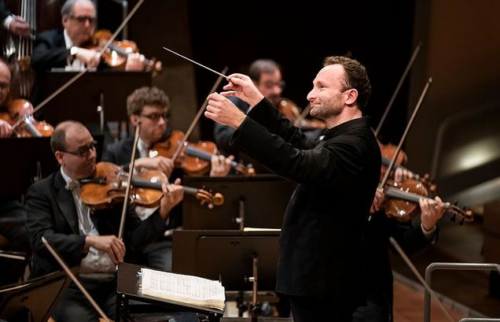 United Kingdom Mendelssohn, Shostakovich: Berlin Philharmonic Orchestra / Kirill Petrenko (conductor). Streamed on Berlin Philharmonic’s Digital Concert Hall from the Philharmonie, 29.10.2021. (GT)
United Kingdom Mendelssohn, Shostakovich: Berlin Philharmonic Orchestra / Kirill Petrenko (conductor). Streamed on Berlin Philharmonic’s Digital Concert Hall from the Philharmonie, 29.10.2021. (GT)

Mendelssohn – Symphony No.3 in A minor, Op.56 ‘Scottish’
Shostakovich – Symphony No.10 in E minor, Op.93
The works of Mendelssohn and Shostakovich are not often programmed together, however, one can understand that both composers have similar early backgrounds of childhood genius; each of them wrote masterly symphonies and achieved world fame when still teenagers and so it provided an interesting contrast. In his pre-concert talk, Kirill Petrenko spoke of his liking for the ‘Scottish’ Symphony, and ‘for its longing, melancholia, deep sadness’, and protested against ‘the way in which Mendelssohn has been pigeon-holed’. Petrenko believes that – especially in this symphony – ‘he was experimenting, having then been a childhood composer growing into adulthood – we can hear already hints of The Flying Dutchman from Wagner, and there is no longer [present] the elf-like music of A Midsummer Night’s Dream, and we can already hear Sturm und Drang in his music, and he borrowed much from Scottish folk music. In the fourth movement, we can hear a martial tone, and to my mind there is the imagery of Scottish freedom fighters – when I hear this music, the films Braveheart and Rob Roy come to mind. There is another aspect in that in the rich-toned acoustics of the Philharmonie Hall, we are hearing this symphony on modern instruments, but Mendelssohn wrote for instruments of the day, and we have to adapt Mendelssohn’s music to modern instruments, so rather than sounding too loud, some of the passages can sound as soft as the composer wanted.’
The opening movement (Andante con moto) was measured in tempo, while the second colourful theme on the strings presented a lyricism, reinforced by especially fine woodwind playing. There emerged an anticipation of the future Wagner in the flowing sway of harmonies on the strings, enhanced by stunning virtuosity from Emmanuel Pahud on flute. Petrenko handled the transitions between lyricism to romantic drama superbly well coaxing the song-like harmonies from his musicians and ensuring the romantic expressionism was fully voiced. The opening of the second movement (Vivace non troppo) was enlightened by brightly lit playing from the clarinet of Wenzel Fuchs – bringing out the hints of Scottish folk tunes. In the third movement (Adagio) the mood was tragic, mournful and the prolonged funeral march descended to a quiet close, in the Allegro vivacissimo finale the dark mood was broken by a reprise of the stirring melody from the opening movement – and now with the horns heralding a battle – the whole orchestra merged in a passage of gripping passion, embroidered with great playing from Fuchs’s clarinet and Stefan Schweigert’s bassoon as we reached a suspenseful pause, before the horns announced an old proud German hymn – ringing out a new harmony – majestically picked up by the whole orchestra in a joyous coda of A major.
In the pre-concert interview, Petrenko said that in Russia the music of Shostakovich was played all the time, and that he had turned away from this music after emigrating with his family, and ‘only recently he had returned to Shostakovich’s music, finding that during the pandemic, this music offered a kind of sanctuary and healing during a period of great stress.’ Petrenko believes that for the composer, ‘this music expressed his inner personal fears, here, I can sense his inner will and personality. This symphony was a creative rebirth for him after several years in which he had not written any symphonies, and as with Tchaikovsky, he tells of personal matters, and of a personal tragedy – this music can never lose its significance – a friend or musician called the Tenth Symphony an “optimistic tragedy”.’
There was a feeling of great tragedy omnipresent in the first movement (Moderato) and of almost impenetrable darkness coming from the depths of the earth in the intonation of the low strings. However, the violins introduced a new theme offering something brighter and unique and notably there was especially fine playing again from Fuchs, and more so, a wonderful idea from Pahud. There was a grim rise in tension which reached a great climax of drama and of threatening imagery, emphasised quite terrifyingly by the percussion. As so often in this composer’s music, there was a transition to a beautiful passage on strings – as if offering a different future – and this mysterious music closed quietly with two piccolo flutes and several gentle beats on the timpani from Wieland Welzel in a passage of otherworldly imagery.
In the second movement (Allegro) there unfurled a brief march played at great pace which was terrifying, devastating, overwhelming and brilliantly executed in what is an orchestral miniature of great evil personified. In the third movement (Allegretto-Largo-Piu mosso) the woodwind was dazzling in virtuosity with the harmony interrupted by a mysterious theme on the horn from Stefan Dohr, repeatedly heard against a tragically moving theme on the strings. Again, the piccolo flute of Michael Hasel was magnificent prior to the poignant intonation from the cor anglais of Dominik Wollenweber before entry into a brisk march which was dynamic and exciting. In the Andante-Allegro-L’istesso tempo finale, the breathtakingly swift changes in pace were brilliantly executed in bringing this great symphony to an exciting and overwhelming close. One was constantly amazed at the virtuosity of each section – together with the whole ensemble – playing at such a fantastic speed and emphasising Shostakovich’s mastery of the symphonic genre. This was the Berlin Philharmonic’s last concert before going on tour throughout Germany and returning for a concert performance of Tchaikovsky’s opera Mazeppa in mid-November.
Gregor Tassie
